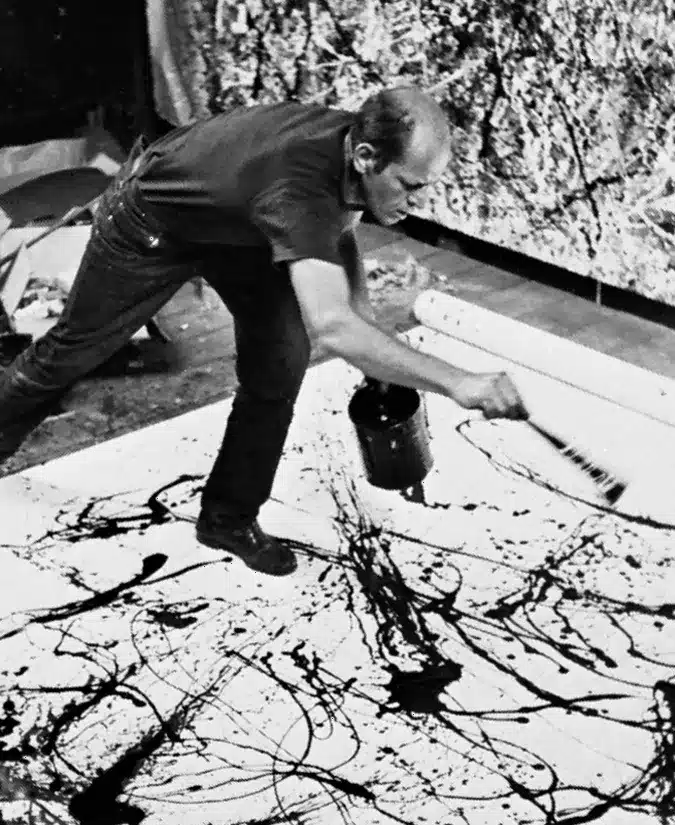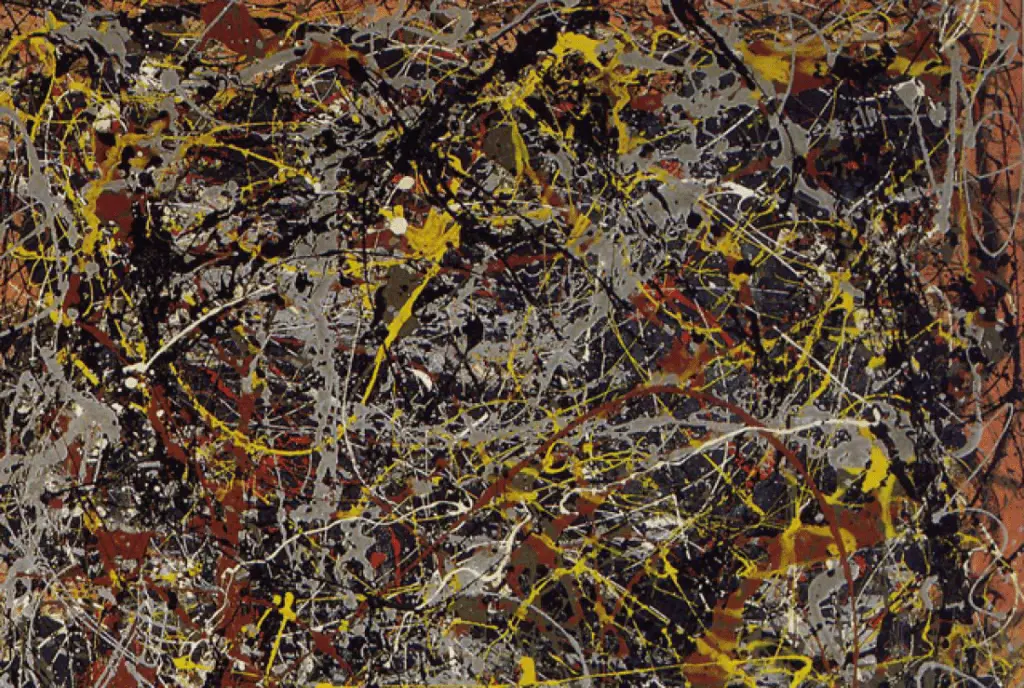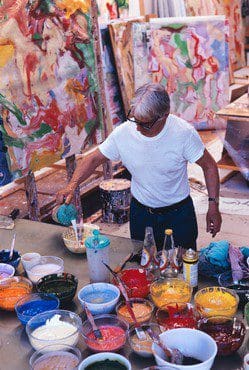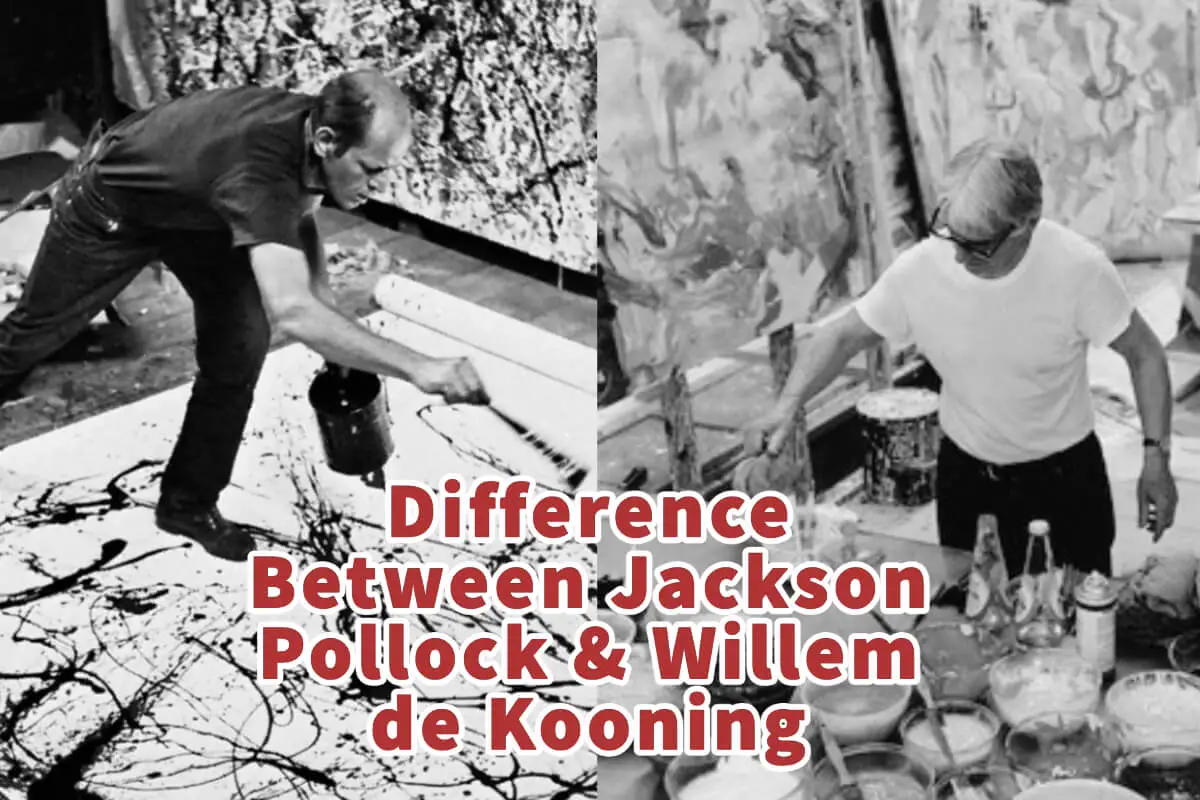Jackson Pollock and Willem de Kooning are both two major abstract expressionism artists. They are both credited with starting the abstract expressionism movement.
Jackson Pollock and Willem de Kooning used different painting techniques and subject matters. Pollock used action painting or what is known as drip painting. Willem de Kooning was fascinated by the female form. The way they both executed their paintings and used paints and canvas was different.
Table of Contents
- Jackson Pollock And Willem De Kooning Explained
- Jackson Pollock And Willem de Kooning’s Differences Explained
- Frequently Asked Questions
- Related Questions
Jackson Pollock And Willem De Kooning Explained
Even though both Jackson Pollock and Willem de Kooning are considered founders of the abstract expressionism movement, their art is very different and takes upon various techniques and looks.
Jackson Pollock – Abstract Expressionism – Drip Painting

Jackson Pollock is best known for his abstract expressionism action painting, which consisted of flinging and dripping thin enamel paint onto the unstretched canvas laid on the floor of his studio. This method of painting was about the action of the painting along with using gravity, velocity, and improvision in the entire artistic process.
When you view his work, you can see lines, drips, marks, and other paint forms on the canvas. His method of painting became known as drip painting, which was not a picture as much as it was about the painting itself.

For him, this was about the emotion of putting the paint on the canvas. As Jackson Pollock himself said:
“When I am in my painting, I’m not aware of what I’m doing. …I have no fears about making changes, destroying the image, etc., because the painting has a life of its own.”
Jackson POllock
Jackson Pollock’s art is not about the subject matter but about the paint and the process of applying that paint on the canvas. When you view his art, you can almost see him listening to the music in his studio, dancing around the canvas, smoking a cigarette, and then dripping and applying the paint onto the canvas.
The drip painting style he began producing in the late 1940s represents one of the most original techniques and works of art ever made in the 20th century. These paintings are so unique that many have tried to copy them but could not.
Willem De Kooning – Abstract Expressionism – The Female Form And Landscapes

William de Kooning was a Dutch-American painter with a long artistic career. He was known to paint women regularly, but it was in the 1950s that he began to explore the subject of women and urban landscapes.
Willem De Kooning is celebrated for his vivid paintings that can sometimes not leave much up to the imagination as he was known to merge abstraction and representation. He had a career as a painter that lasted over seven decades; he experimented with many new techniques and forms.

One form that he was always fascinated with was the human figure, particularly the female body and form. But what makes De Kooning’s art so great and unique is the ability to use color. Many of his paintings have unique textures and colors.
Sometimes, he would scrap down the paint and repaint an entire canvas section. He was also known to mix other substances into some paints to give them a gritty look. He might mix things such as sand or pebbles into the paint.
He also applied and played with his paint to paint layer upon layer for a painting. Willem de Kooning was known for changing his paintings and techniques throughout his long artistic career.
In speaking of his paintings, Willem De Kooning said:
“I never was interested in how to make a good painting…I didn’t work on it with the idea of perfection, but to see how far one could go…”
Willem De Kooning
For Willem de Kooning, it was also about the action of painting, but his paintings had a different spontaneity than Jackson Pollock. It was not the subject matter as much as how the paint was applied on the canvas using large brushes and brush strokes.
Jackson Pollock And Willem de Kooning’s Differences Explained
Jackson Pollock and William de Kooning are considered to be great abstract expressionism artists. They were both leaders in the art movement and have influenced many other painters who have gone after them.
They both understood how to use paint, color, and texture in their artwork. But there are also some differences:
- Jackson Pollock used a drip painting in his action painting technique. He would put the canvas on the floor and throw the paint onto the canvas. William de Kooning also used a lot of texture in his paintings, but at the same time, he was more concerned with the female form and spontaneity of his paintings.
- Willem de Kooning had a subject matter in his work (women or urban landscapes), but Jackson Pollock’s work was non-subjective or had no identifiable subject matter.
- Willem de Kooning used brushes to paint on canvas; he used an easel also to paint with. Jackson Pollock did not use an easel but put the canvas on the floor and dripped paint on it.
- De Kooning mixed a lot of color on the canvas as he applied the art to the canvas. Pollock’s paintings are made with layers and layers of paint.
- Jackson Pollock and Willem de Kooning are action painters because of their art’s spontaneity and improvised manner. They both used large brush strokes. But the final execution of their paintings was very different.
- Willem de Kooning lived until his 90s but suffered for a long time from Alzheimer’s disease, which caused him not to be able to paint for a long time. Jackson Pollock died at 44 years old in a tragic car accident.
Both Jackson Pollock and Willem de Kooning are abstract expressionism artists; they are very different in how they executed their artwork and the type of artwork they produced. They are both considered at the forefront of the Abstract Expressionism movement.
Anita Louise Art is dedicated to art education, great artists, and inspiring others to find and create their art. We love art that uplifts and inspires. #ArtToMakeYouSmile! #ArtToMakeYouHappy!
If you want to see any of my art, you can find out more by clicking here. If you are interested in what inspires me and my paintings, you can discover more by clicking here.
We have a free newsletter and would love you to be part of our community; you can subscribe to the newsletter by clicking here. I would be happy to talk to you if you have any questions. You can reach me, Anita, by clicking here.
Subscribe to our Anita Louise Art YouTube Channel with great videos and information by clicking here.
Join us for our podcast “5 Minutes With Art.” Spend 5 minutes a week with us to discover and learn about great art and artists. You can find out more about our podcast by clicking here.
Frequently Asked Questions
How did Jackson Pollock and Willem de Kooning contribute to the abstract expressionism movement?
Both artists are considered pioneers of abstract expressionism, but their contributions vary. Understanding their unique approaches sheds light on the movement’s diversity.
What is the primary painting technique associated with Jackson Pollock, and how does it differ from Willem de Kooning’s approach?
Jackson Pollock is renowned for his drip painting or action painting technique, where he would fling or pour paint onto the canvas. In contrast, Willem de Kooning employed a more controlled approach, emphasizing brushwork and form in his works.
How did Jackson Pollock’s emphasis on spontaneity and randomness differ from Willem de Kooning’s more controlled approach in their artworks?
Pollock embraced the unpredictability of his drip technique, allowing chance to play a significant role. De Kooning, on the other hand, focused on deliberate strokes and a more measured execution.
What was the main subject matter that fascinated Willem de Kooning in his paintings, and how did it manifest in his works?
Willem de Kooning was captivated by the female form. His paintings often featured distorted and abstracted representations of the female figure, showcasing his unique interpretation of this theme.
How did the use of paints and canvas differ between Jackson Pollock and Willem de Kooning?
Pollock’s method involved pouring and dripping paint onto canvas laid on the floor, creating a sense of fluidity and depth. De Kooning, in contrast, applied paint more conventionally with brushes, emphasizing texture and form.
Can you explain the role of spontaneity in Jackson Pollock’s paintings and how it contributed to the overall aesthetic of his artworks?
Spontaneity was crucial in Pollock’s works, allowing him to express raw emotions and energy. The unpredictability of his drip technique conveyed a sense of immediacy and dynamism in his paintings.
In what ways did Willem de Kooning’s exploration of the female form contribute to the evolution of his artistic style over time?
De Kooning’s fascination with the female form evolved throughout his career, leading to various phases of abstraction. Understanding these phases helps appreciate the depth and complexity of his artistic development.
How did the cultural and artistic context of their time influence the works of Jackson Pollock and Willem de Kooning?
Both artists were active during a period of significant artistic transformation and cultural shifts. Exploring this context provides insights into the external factors that shaped their artistic choices.
Can you elaborate on the influence of psychological aspects in Jackson Pollock’s drip paintings and how it differed from Willem de Kooning’s more figurative works?
Pollock’s drip paintings are often analyzed in psychological terms, emphasizing the subconscious and emotional aspects. In contrast, de Kooning’s exploration of the female form brings forth psychological complexities related to identity and representation.
How did Jackson Pollock and Willem de Kooning impact the trajectory of abstract expressionism, and what is their enduring legacy in the art world?
Examining the lasting impact of these artists on the abstract expressionism movement helps us understand their influence on subsequent generations of artists and the broader art world.
Related Questions
How Do I Make Money From My Abstract Art?
To sell your abstract art is the same as selling any other art. It will take a lot of time and effort. To sell the art, you must first have the product or the artwork, and then you must work on finding a way to promote your art. There are many ways that you can promote to sell your art.
By clicking here, you can learn more by reading How Do I Make Money From My Abstract Art?.
Can Anyone Be An Abstract Artist Without Any Talent In Painting?
To be a great abstract artist, you need talent and an understanding of painting. Painting can be a technical skill that artists spend a lifetime perfecting through their art education and practice. Great abstract artists have had intensive training in painting, drawing, composition, and color theory.
You can learn more by reading the blog Can Anyone Be An Abstract Artist Without Any Talent In Painting? by clicking here.
Abstract Painting Skills And An Artist’s Drawing Ability
When an artist is trained in drawing, composition, and color theory, their formal or informal training is reflected in their artwork. You can tell the artist’s skills by executing the painting using their drawing, composition, and color theory skills.
You can read more by reading our blog Abstract Painting Skills And An Artist’s Drawing Ability by clicking here.


